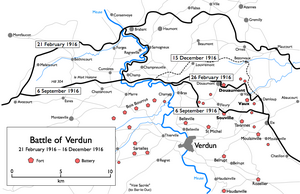Battle of Verdun
| Battle of Verdun | |||||||
|---|---|---|---|---|---|---|---|
| Part of the Western Front of the First World War | |||||||
 Map: Battle of Verdun 1916 |
|||||||
|
|||||||
| Belligerents | |||||||
|
|
|
||||||
| Commanders and leaders | |||||||
|
Joseph Joffre Noël de Castelnau Fernand de Langle de Cary Frédéric-Georges Herr Philippe Pétain Robert Nivelle Adolphe Guillaumat Auguste Hirschauer Charles Mangin |
Erich von Falkenhayn Crown Prince Wilhelm Schmidt von Knobelsdorf Ewald von Lochow Max von Gallwitz Georg von der Marwitz |
||||||
| Strength | |||||||
| 1,140,000 soldiers in 75–85 divisions | 1,250,000 soldiers in c. 50 divisions | ||||||
| Casualties and losses | |||||||
| 315,000–542,000 (156,000–162,000 killed) February–December 1916 | 281,000–434,000 (c. 143,000 killed) February–December 1916 | ||||||
The Battle of Verdun (Bataille de Verdun, IPA: [bataj də vɛʁdœ̃], Schlacht um Verdun, IPA: [ʃlaxt ˀʊm ˈvɛɐdœŋ]), fought from 21 February to 18 December 1916, was one of the largest and longest battles of the First World War on the Western Front between the German and French armies. The battle took place on the hills north of Verdun-sur-Meuse in north-eastern France. The German 5th Army attacked the defences of the Région Fortifiée de Verdun (RFV) and those of the French Second Army on the right bank of the Meuse. Inspired by the experience of the Second Battle of Champagne the year before, the Germans planned to rapidly capture the Meuse Heights, providing them with an excellent defensive position that would also allow them to bombard Verdun with observed artillery fire. The Germans hoped that the French would commit their strategic reserve to recapture the position and suffer catastrophic losses in a battle of attrition, as the Germans would have a tactical advantage.
Poor weather delayed the beginning of the German attack until 21 February, but the Germans enjoyed initial success, capturing Fort Douaumont in the first three days of the offensive. Afterwards the German advance slowed, despite many French casualties. By 6 March, 20 1⁄2 French divisions were in the RFV and a more extensive defence in depth had been constructed. Pétain ordered that On ne passe pas (no withdrawals) were to be made and that counter-attacks were to be conducted, despite exposing French infantry to fire from the German artillery. By 29 March, French artillery on the west bank had begun a constant bombardment of German positions on the east bank, which caused many German infantry casualties.
...
Wikipedia
